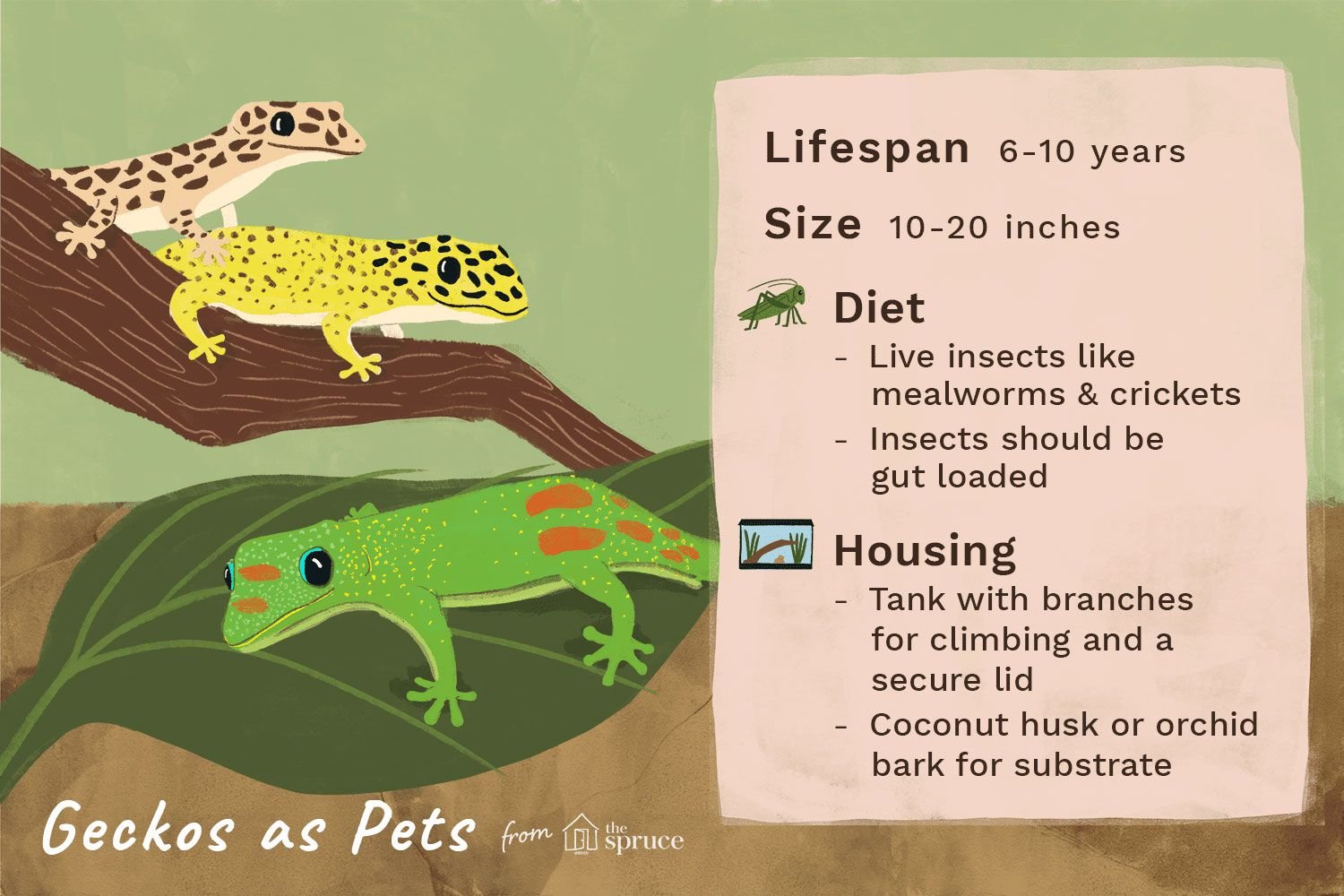A guide to pet geckos: Learn how to care for geckos as pets, including housing, handling, diet, exercise, and health. Gecko facts: Live insects are essential, and heat, light, and humidity are crucial.
Leopard geckos are a popular choice for beginners due to their availability and various patterns and colors. Geckos make great pets as they are docile, easy to tame, and relatively easy to care for. Avoid using sand as substrate and note that geckos can regrow their tails and teeth.
Follow this care guide to ensure the well-being of your pet gecko.
:strip_icc()/guide-to-geckos-1236898-hero-aed0e806156a415f99cfcd7d65987849.jpg)
Credit: www.thesprucepets.com
Introduction To Pet Geckos
Welcome to our comprehensive guide on pet geckos! In this section, we will provide an overview of geckos as pets, discuss the benefits of owning a gecko, and introduce you to some popular gecko species. If you’re considering getting a pet gecko, this guide is the perfect resource for you.
Overview Of Geckos As Pets
Geckos are fascinating reptiles that make wonderful pets. They come in a variety of species, each with its unique characteristics and care requirements. As pet geckos, they are known for their gentle nature and low maintenance needs, making them an ideal choice for beginner reptile owners.
Geckos are nocturnal creatures and are typically active at night, which means they follow a different schedule compared to other pets. They have a unique ability to climb walls and ceilings due to their specialized toe pads, which make them highly adaptable to various environments.
When it comes to size, geckos vary significantly depending on the species. While some geckos are small and can comfortably fit in the palm of your hand, others can grow up to several inches long. This size variation allows you to choose a gecko that fits your preferences and available space.
Benefits Of Owning A Gecko
There are numerous benefits to owning a pet gecko, making them a popular choice among reptile enthusiasts:
- Low Maintenance: Geckos require minimal care compared to other pets. They don’t need to be walked, groomed, or fed multiple times a day.
- Quiet and Calm: Geckos are relatively quiet animals, perfect for those living in apartments or spaces where noise needs to be kept to a minimum.
- Fascinating to Observe: Geckos have unique behaviors and traits that make them captivating to observe. From their ability to stick to walls to their hunting techniques, there’s always something interesting happening in their enclosure.
- Long Lifespan: Depending on the species, geckos can live anywhere from 10 to 20 years or even longer with proper care. This means you can enjoy their companionship for a significant portion of your life.
Popular Gecko Species
There are several popular gecko species that make excellent pets. Here are some of the most commonly kept gecko species:
| Species | Characteristics |
|---|---|
| Leopard Gecko | Small size, docile temperament, and variety of color morphs |
| Crested Gecko | Nocturnal, arboreal, and known for their unique crests and soft skin |
| African Fat-Tailed Gecko | Similar in appearance to the leopard gecko but with a fatter tail |
| Day Gecko | Energetic and brightly colored geckos that require a more specialized setup |
These are just a few examples of the many gecko species available as pets. Each species has its own care requirements and unique characteristics, so make sure to research and choose the one that suits your preferences best.

Credit: www.walmart.com
Caring For Pet Geckos
Caring for pet geckos is essential for keeping them happy and healthy. From providing live insects for their diet to ensuring proper heat, light, and humidity levels, there are a few crucial things beginners need to know before getting a pet gecko.
Leopard geckos are a popular choice for their docile nature and variety of patterns and colors.
Housing And Enclosure
When it comes to housing a pet gecko, it’s important to create a suitable environment that mimics their natural habitat. Geckos require a secure enclosure that provides enough space for them to move around comfortably. The size of the enclosure largely depends on the species of gecko you have, so it’s crucial to do your research beforehand. A glass tank or terrarium with a secure lid is recommended to prevent any escapes.
Inside the enclosure, you’ll need to set up various features to ensure your gecko feels at home. Provide a heat source, such as an under-tank heating pad, to maintain the proper temperature gradient within the enclosure. It’s essential to offer a temperature gradient, with a warm side reaching around 85°F (29°C) and a cooler side around 70°F (21°C), so your gecko can regulate its body temperature as needed.
In addition to heat, geckos require a proper lighting setup. Use a UVB light to mimic natural sunlight and promote vitamin D synthesis, which aids in calcium absorption. Remember to provide hiding spots, such as rocks, logs, or plants, to create a sense of security for your gecko. These hiding spots can also serve as temperature gradient aids.
Feeding And Diet
Feeding pet geckos can be relatively straightforward as most species are insectivorous. They primarily feed on live insects, such as crickets, mealworms, and dubia roaches, which you can easily find at pet stores or through online suppliers. Ensure the insects are appropriate in size for your gecko’s mouth, so they can easily swallow them without any issues.
It’s important to provide a varied diet to ensure your gecko receives all the necessary nutrients. Dust the insects with calcium and vitamin D3 supplements before feeding, as geckos require high levels of calcium for healthy bones and proper organ function. Additionally, you can introduce occasional treats like waxworms, silkworms, or small pieces of fruit as a source of hydration and added variety.
Handling And Interaction
Handling a pet gecko requires gentle and careful approach. It’s crucial to allow your gecko time to acclimate to its new environment before attempting any handling. Start by offering mealworms or other treats from your hand to build trust and establish a positive association. Once your gecko becomes comfortable, you can begin slow and gentle handling sessions.
When picking up your gecko, avoid grabbing its tail, as it could detach or lead to stress. Instead, gently scoop them up from underneath, supporting their body and limbs. It’s important to handle your gecko regularly to promote socialization and reduce stress. However, always be mindful of their comfort and never force them into any interactions they are not ready for.
Health And Common Diseases
Monitoring the health of your gecko is crucial for their overall well-being. Ensure their enclosure is kept clean and free from any potential hazards, such as sharp objects or overheating. Regularly check for any signs of illness, such as loss of appetite, abnormal stool, or changes in behavior.
It’s recommended to establish a relationship with a reptile veterinarian who can provide routine check-ups and address any health concerns. Some common diseases that geckos may suffer from include respiratory infections, metabolic bone disease, or parasitic infections. Regular veterinary care, proper nutrition, and a clean environment can help prevent these issues.
In conclusion, caring for a pet gecko requires attention to their housing and enclosure, a well-rounded diet, gentle handling and interaction, as well as monitoring their health for any signs of illness. By providing the appropriate care, you can ensure your pet gecko thrives in their new home and brings you joy for years to come.
Choosing The Right Pet Gecko
When it comes to choosing the right pet gecko, it’s important to consider the species that best suits your lifestyle and preferences. Each type of gecko has its unique care requirements and characteristics. Let’s take a look at some of the popular pet gecko species:
Leopard Geckos
Leopard geckos are always a good choice for reptile beginners. They are easy to find at your local pet store or reptile show and come in an array of patterns and colors, referred to as different morphs. These geckos are known for their docile nature and are less likely to bite or drop their tails. They require a warm and dry habitat, with a heat source and adequate hiding spots. Leopard geckos also have specific dietary needs, primarily consisting of live insects.
Crested Geckos
Crested geckos are another popular choice among pet gecko enthusiasts. These geckos are known for their unique appearance and ability to climb walls using specialized toe pads. They are relatively low-maintenance compared to other geckos and do not require UVB lighting. Crested geckos primarily feed on commercially available powdered diets mixed with water. They are also known for their gentle temperament and make great pets for both beginners and experienced reptile keepers.
Day Geckos
Day geckos, as the name suggests, are active during the day and require special lighting to simulate natural sunlight. These geckos are visually stunning, with vibrant colors and striking patterns. They are generally more active and require larger enclosures with plenty of vertically arranged branches and foliage to climb on. Day geckos also have specific dietary needs, consisting of a variety of insects, fruit, and nectar.
Other Popular Gecko Species
In addition to leopard geckos, crested geckos, and day geckos, there are other popular gecko species that you might consider as a pet. Some of these include:
- African fat-tailed geckos
- Gargoyle geckos
- Common house geckos
Each of these species has its unique care requirements and temperament. It’s important to research and understand the specific needs of these gecko species before making a decision.
Whether you choose a leopard gecko, crested gecko, day gecko, or any other popular gecko species, it’s crucial to provide them with a suitable habitat, proper nutrition, and the care they need to thrive. As with any pet, it’s important to consider your commitment level and ability to meet the needs of the gecko species you choose.

Credit: www.walmart.com
Frequently Asked Questions Of A Guide To Pet Geckos
What Do You Need To Know Before Getting A Pet Gecko?
Before getting a pet gecko, keep in mind the following: – Live insects are important in their diet – Proper heat, light, and humidity are necessary – Avoid using sand as substrate – Geckos come in various patterns and colors – They eat their shed skin and can regrow their tails.
What Is The Best Pet Gecko For Beginners?
The best pet gecko for beginners is the leopard gecko. They are easy to find, come in various patterns and colors, and are docile and easy to tame. Geckos are popular reptile pets as they are relatively easy to care for, making them a great choice for beginners.
Does A Gecko Make A Good Pet?
Geckos make good pets, especially for beginners. They are easy to tame, docile, and relatively easy to care for. In particular, the leopard gecko is a popular choice for a reptile pet. They are fun and enjoyable companions.
How Do You Take Care Of A Gecko For Beginners?
To take care of a gecko for beginners, make sure to provide appropriate housing and an enclosure with climbing branches. Live insects should be included in their diet, and heat, light, and humidity are crucial. Avoid using sand as substrate.
Geckos, like Leopard geckos, are docile and easy to tame, making them a popular choice for beginners.
Conclusion
Pet geckos make fantastic companions for reptile enthusiasts. From their unique patterns and colors to their docile nature, geckos are an excellent choice for beginners. When caring for a pet gecko, it’s crucial to provide live insects, maintain proper heat, light, and humidity levels, and avoid using sand as a substrate.
Additionally, geckos have fascinating abilities, such as regrowing their tails and teeth. By ensuring a suitable enclosure and meeting their basic needs, you can enjoy the company of these wonderful creatures.


